Most growers will pay attention when you start talking about how they can reduce fertilizer use and tillage passes, all while maintaining or even improving yield. But most growers are also terrified a new tool or technique will not work for them. In the case of strip-tilling, it only takes a season for things to go sideways — which puts pressure on the dealer to get things right.
Selling a strip-till rig isn’t as simple as pointing to some canned option on the showroom floor. There are different types of toolbars and strip-till units themselves, each of which is better suited to different types of conditions. Setting a customer up for success requires dealers to understand what the options are, and how to best match those options to a given grower’s needs and expectations.
“Over the 7 years we’ve been selling strip-till equipment, the interest we’re seeing has easily doubled,” says Pete Youngblut, owner of Youngblut Ag in Dysart, Iowa, a precision ag technologies dealership that also carries Yetter attachments and strip-till units, Harvest International planters and strip-till bars, and Fast Ag Solutions sprayers and strip-till bars.
The growing interest in strip-till can largely be attributed to a grower’s desire to reduce operating costs. But additionally, Youngblut says growers trust him because he himself strip-tills in his own farming operation. “Being able to show customers how this actually works has made all the difference in the world,” Youngblut relates.
Another Iowa dealer/strip-tiller, Zach Reiter, shares a similar sentiment.
“I had been wanting to get into strip-till on our own farm for a long time,” says Reiter, co-owner of Z&J Farms, an equipment dealership in Cascade, Iowa, that opened in 2009. “So we took on TruAG as a dealer so we could start using it ourselves in 2016. Now we’ve been having a lot of success in selling strip-till equipment, and a big reason why is that we use it ourselves. We live it and understand it, and farmers trust us.” Z&J Farms’ current equipment offering includes the Lynx, AGuru and Yetter strip-till lines.
Enticed by Efficiency
Youngblut says many growers are interested in strip-till, but nervous about investing in new equipment. Dealers can calm some of those nerves by explaining how a grower can see an attractive ROI over time by gaining several efficiencies in the field.
Most of Youngblut’s strip-till customers are what he calls conventional converts. “They look at their current cost of operation — fuel for the tractor, time spent field-cultivating and soil-finishing, and paying a co-op to apply fertilizer,” Youngblut says. “Those costs really add up, especially if the fertilizer wasn’t applied right and you’re taking a beating on yield. We’re talking thousands of dollars. When you look at it that way, the cost of some new strip-till equipment starts to make sense.”
Reiter says strip-till is starting to make more sense to more of his customers, both conventional converts and those coming from the no-till side.
“Nutrient efficiency is a huge issue for everybody,” Reiter says. “With strip-till, nutrient placement is much more precise (directly in the row), enabling conventional growers to see a substantial reduction in fertilizer use. With no-till farmers, maybe they’ve been seeing some nutrient stratification. And because of that, maybe they’ve been seeing declining yields. With strip-till, the nutrients are being precisely mixed into the soil profile.”
Equipment efficiency is another motivator for conventional converts. “If you’ve been a full-tillage guy, you’re getting rid of a chisel plow pass in the fall, one or two fertilizer passes and probably another tillage pass in the spring,” Reiter says. “When you start looking at the efficiency of your equipment investment, strip-till has a huge advantage.”
In an arid environment like West Texas, there is a slightly different motivation for getting into strip-till. Growers want to break up the ground that’s needed for the seed and root but avoid disturbing any more than that.
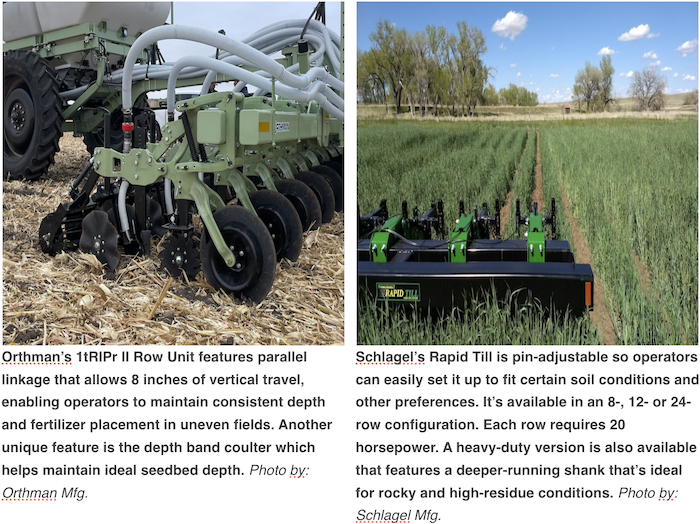
“We’re on a wider 40-inch pattern here,” says Andy Copeland, branch manager for South Plains Implement’s Abernathy, Texas, location. “We try to leave as much in the middle as we can since we’re trying to do a minimal till. Growers are finding that strip-till is a good option.” South Plains Implement is a John Deere dealer with 19 locations in West Texas and New Mexico. Among the dealership’s shortlines are the Schlagel, Orthman, Bigham Ag and SM Fab brands of strip-till equipment.
Strip-Till Solves a Cover Crop Challenge
Many dealers are also seeing increased use of cover crops. Cover crops and strip-till can go hand in hand.
Look at West Texas, for instance. It’s cotton country, and there isn’t much residue from those cotton stalks. That’s why more growers have begun planting cover crops — and they’re planting them early. “If it’s failed dryland from the prior year, they’ll often plant as early as September or October,” Copeland says.
That cover crop will get a West Texas grower through winter and into spring when it’s sprayed.
“This is where strip-till comes in,” Copeland says. “Minimal tillage is preferred on dryland. Growers aren’t running very deep on this cotton ground, either, maybe only 4 or 5 inches. They can accomplish both with strip-till where they’re freshening up a spot to be planted. And if we do get some rain, that strip creates a spot to absorb a little more moisture right where the seed is planted.”
Up in Central Indiana corn-soybean country, AJ Adkins has also seen growth in both cover crops and strip-till. He recognized the potential of leveraging them together while operating equipment at Starkey Farms many years ago. They’d been planting annual ryegrass for a few years and could see the benefit it was having on no-till soil structure. But there was a problem.
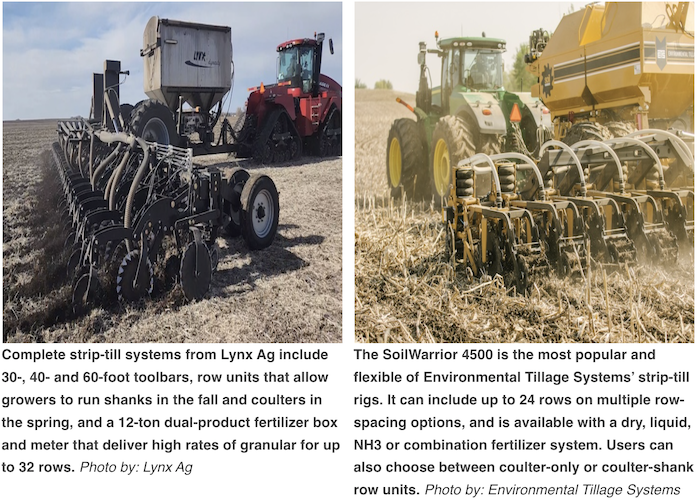
“Trying to plant into that no-till ground was a nightmare, regardless of whether the cover crop was burnt-down or green,” says Adkins, owner of NTM Ag Equipment in Brownsburg, Ind., a dealership he started in 2013 that carries Dawn and Lynx strip-till equipment. “That’s why we started looking at strip-till. We saw an opportunity to marry the two concepts together.”
In addition to being a dealer, Adkins is also a complete implement specialist for Dawn Equipment where he works with both dealers and growers across a large territory. One of the frustrations he sees from no-till customers is the inevitable variability from one season to the next, which makes it a challenge to keep the planter dialed in when planting into cover crops.
“When strip-tilling a week or so ahead of the planter, you don’t have those challenges,” Adkins says. “A lot of times, we don’t even need row cleaners on the planters anymore; we can just run a basic closing wheel. Strip-till minimizes all of those variables a no-till farmer has to wrestle with year to year. Plus, anything we can do to get the planter to be more efficient, the better.”
Matching Tool to Season & Conditions
A strip-till rig is a somewhat complex implement with several jobs to do. In many instances, a series of coulter blades are at the front of the configuration, followed by row cleaners, tillage shanks and berm-building discs. Conditioning baskets or some other kind of soil-smoothing devices are at the rear. All components are mounted to a 3-point toolbar that either attaches to the tractor or functions as a pull-behind unit. A fertilizer delivery system is also frequently incorporated for additional efficiency gains.
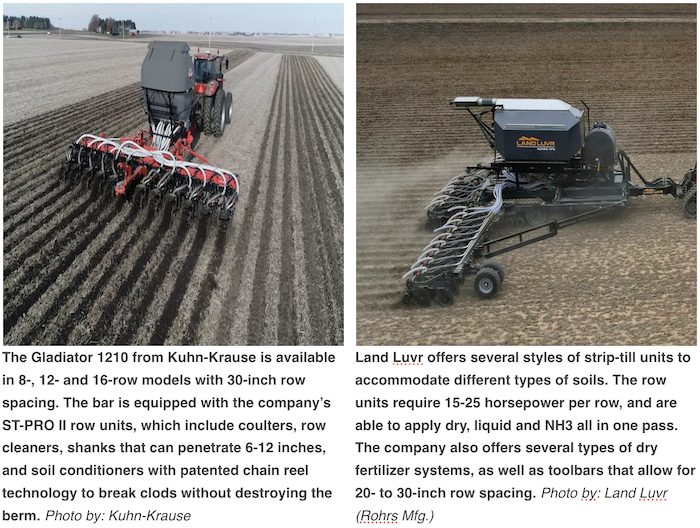
There is no one size fits all solution. For instance, Land Luvr (Rohrs Mfg. in Ohio) makes a variety of strip-till units that are specifically designed for different soil types. There are also coulter-only (no shank) units for growers who want to run shallower and faster. Furthermore, every brand has its own unique features that can provide certain advantages when it comes to things like ease of use, durability, operating on uneven terrain, and seasonal use.
Speaking of seasonal use, a Special Management Report from Ag Equipment Intelligence published in 2021 presented data suggesting that slightly more growers are looking to strip-till in the fall vs. the spring. But 21% want to strip-till both seasons, which can create some unique equipment requirements.
As a general rule, Adkins says fall strip-till is best served by a heavier and more aggressive tool, typically a shank-style unit that can penetrate deeper. Strip-tillers won’t want to go as deep in the spring, however, which opens the door to more of a coulter-style unit. Some manufacturers also offer what they call “strip fresheners” that just loosen up the top few inches to create a nice seedbed prior to planting. They can typically be incorporated into the same strip-till bar when needed.
As a grower, Reiter likes the option of using his strip-till rig in either fall or spring. More of his customers are desiring that option, too.
“You try to get as many acres done as possible in the fall, but there are always situations where you can’t,” Reiter says. “The strip-till bars we sell are convertible from a shank to a coulter-style system, which helps provide some additional flexibility. These bars are too expensive to expect a grower to invest in 2 of them.”
Reiter says some of his customers wonder if they could also run a coulter-style unit in the fall. He says it’s possible, but only when conditions are quite favorable. “A coulter-style unit can struggle in the fall after trucks and grain carts have left tracks all over the place,” Reiter explains. “A coulter will typically float over that hardpack, whereas a shank will suck itself in.”
Youngblut says a coulter-style unit can perform well in the fall, if it’s well-designed. His biggest seller, the Yetter 2984 CC, is one example. Although it’s marketed as a strip freshener, Youngblut says it also does a nice job of creating new strips. Using a multiple-circuit air system, growers can easily make adjustments to air pressure settings from the cab. It also features parallel linkage so each row can follow changing field conditions.
Youngblut shares a personal example from his own farming operation. “I wanted to apply P and K in the strip last fall. Using my coulter unit, I was able to build those strips while going through cover crop and bean stubble. Then I came back in the spring to run at a lighter setting to freshen those strips up, while also applying urea and AMS at the same time. That worked really well for me,” Youngblut says.
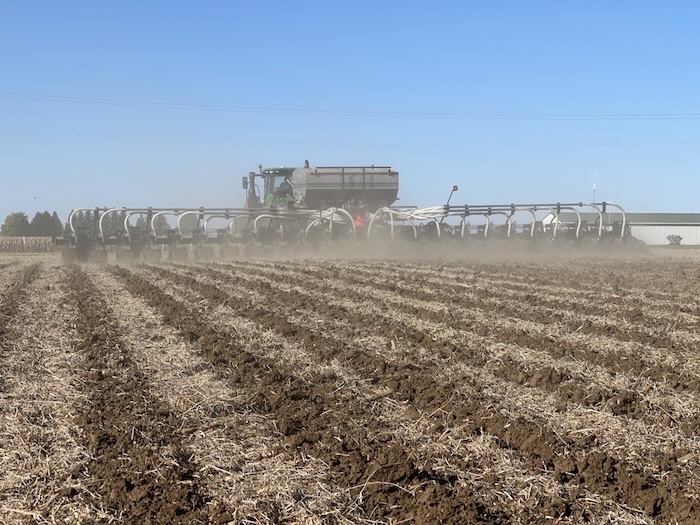 Dawn Equipment’s Black Dawn One is a complete pull-type strip-till toolbar and fertilizer delivery system. It includes a 9-ton tank and is equipped with Dawn’s Pluribus V row unit. Pluribus V is a coulter system with row-by-row hydraulic control, enabling it to work in a wide range of conditions in fall or spring. Photo by: Dawn Equipment
Dawn Equipment’s Black Dawn One is a complete pull-type strip-till toolbar and fertilizer delivery system. It includes a 9-ton tank and is equipped with Dawn’s Pluribus V row unit. Pluribus V is a coulter system with row-by-row hydraulic control, enabling it to work in a wide range of conditions in fall or spring. Photo by: Dawn Equipment
Adkins is also having dual-season success with a well-designed coulter-style unit. Dawn’s Pluribus V is ideal for spring. But it also features hydraulic down pressure, which helps make it effective in the fall, too, when the soil is dryer and tighter.
Down in arid West Texas, Copeland says a less aggressive strip-till unit is typically the best fit. He does especially well with Schlagel’s Rapid Till. It’s a shank/coulter unit, but the shank point isn’t as aggressive as some strip-till units. The shank can also be adjusted from 2-11 inches, whereas the Rapid Till HD (heavy duty) can be adjusted from 6-16 inches.
RAPID-TILL: Schlagel’s Jonathan Spence sold world soybean champ Alex Harrell the strip-till machine that helped produce a 206-bushel yield. Spence explains how Rapid-Till helped Harrell break the world record. #FPS2023 #FarmProgressShow pic.twitter.com/v9UZTyDKIs
— Strip-Till Farmer (@StripTillFarmr) August 31, 2023
“My customers typically aren’t looking to run very deep, which is why we sell more of the standard Rapid Till,” Copeland says. “Still, we have sold some heavy-duty versions. One customer was a drip tape company that ran it deep out in front of their drip tape rig. The Rapid Till HD was plenty stout enough for our hard, dry ground.”
The reality is that every grower has different objectives and challenges. “Our job as dealers is to find out what they are and point the customer toward the right equipment for their farm,” Reiter says.
Right-Sizing the Rig
One thing to consider is tractor size. Depending on various factors such as shank depth and ground conditions, a strip-till rig could require as much as 25 or 30 horsepower per row. “If you want to pull a 16-row toolbar, that could take a pretty big pony,” Youngblut points out.
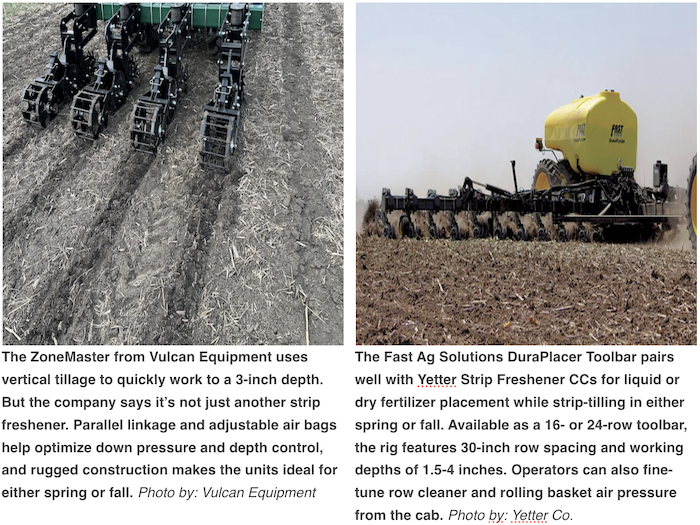
That horsepower requirement is another reason why a shankless coulter-style unit is Youngblut’s most popular seller. That Yetter 2984 only needs 15 horsepower per row, Youngblut says, which gives growers an opportunity to stay in that 16-row configuration without needing such a large tractor.
According to data presented in that 2021 Special Management Report from Ag Equipment Intelligence, 25% of strip-till farmers like to go with a 16-row configuration. A 12-row is the most popular at 38%. Roughly 32% prefer just 6 or 8 rows.
Up in Indiana, Adkins concurs that a 12-row setup is most common. However, he’s also seeing more high-production growers (2,000-12,000 acres) bumping up to 24-row on a 60-foot toolbar to match up with their 24-row planters. Adkins’ big seller is that coulter-style unit from Dawn called the Pluribus V. It requires 12-20 horsepower per row, depending on which specific model is chosen. That helps make a 24-row setup more attainable to more growers.
At the end of the day, it’s the dealer’s job to find out what an individual grower truly needs to be successful.
“If the customer is a full-tillage guy with a 600-horsepower tractor who wants to save passes across the field, we’ll look to get him into a 24-row setup on a Lynx shank bar,” Reiter shares as an example. “If the customer is a no-till guy who’d like to put some fertilizer down, and is a 12-row guy with a 250- to 300-horsepower tractor, we want to set him up with a rig to make lighter strips. We have to ask a lot of questions to find out what they are capable of and looking to accomplish.”
Fertilizing is the Final Piece
As Reiter just alluded to, the fertility aspect of strip-tilling will likely come into play at some point. When a grower can precisely apply fertilizer at the same time they are creating or freshening strips, the number of field passes they have to make is reduced. That reduces labor, fuel and fertilizer costs, which presents the clearest path to ROI.
Reiter says all of his existing strip-till customers want application equipment added to the toolbars they are updating. With new customers, 75% want to incorporate fertilizing immediately. The rest hope to add it in the future. “We like to determine that upfront so we can work with the customer on buying a toolbar that allows application equipment to easily be added later,” Reiter says.
Adkins says half of his new customers want to incorporate fertilizing immediately. The other half come back for it in a year or two. He’s fine with that. “The last thing I want to do is throw too much at a customer right away. Most of the row units I sell have bolt-on fertilizer tubes that are easy to add at any time,” Adkins says.
For growers looking to do fall strip-till, Adkins says a dry setup is best. Liquid becomes a feasible option when strip-tilling in the spring. For those looking to run their equipment both seasons, dry is typically the best option. That is why two-thirds of Adkins’ customers opt for a dry setup.
Adkins also likes to find out how many products the customer is looking to apply. Then he can ensure that the customer owns or has access to a proper tender.
The rate controller is another important piece of the puzzle that can’t be overlooked.
“This is where a lot of startup issues arise,” Adkins says. For example, say the rate controller isn’t communicating with the fertilizer pump. Many times, it’s something as simple as an unchecked box on the monitor. This is why Adkins likes to be present at startup to help troubleshoot some of these little issues that can pop up.
Guidance is another key element of making a strip-till operation work. Fortunately, the dealers interviewed for this story say the majority of their customers have already invested in this technology. So the only thing that stands in the way of stepping into strip-till is the strip-till rig itself. By asking the right questions and presenting the best options, dealers can calm their customers’ nerves and set them up for strip-tilling success.






